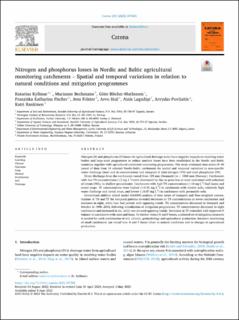| dc.description.abstract | Nitrogen (N) and phosphorus (P) losses via agricultural drainage water have negative impacts on receiving water bodies and large-scale programmes to reduce nutrient losses have been established in the Nordic and Baltic countries, together with agricultural catchment monitoring programmes. This study evaluated time series (9–40 years) of data from 34 selected Nordic-Baltic catchments for spatial and temporal variations in area-specific water discharge (mm) and in concentrations and transport of total nitrogen (TN) and total phosphorus (TP). Water discharge from the catchments varied from 125 mm (Denmark) to > 1000 mm (Norway). Catchments with low TN concentrations (≤3 mg L-1) were dominated by clay or grass leys or were undrained with reduction of nitrate (NO3) in shallow groundwater. Catchments with high TN concentrations (≥10 mg L-1) had loams and cereal crops. TP concentrations were highest (≥0.45 mg L-1) in catchments with erosive soils, relatively high water discharge and cereal crops, and lowest (≤0.07 mg L-1) in catchments with permeable soils. Generalised additive mixed model (GAMM) analysis of time series of transport and flow-weighted concentrations of TN and TP for temporal patterns revealed decreases in TN concentrations in seven catchments and increases in eight, while four had periods with opposing trends. TN concentrations decreased in Denmark and Sweden in 1990–2010, following introduction of mitigation programmes. TP concentrations decreased in eight catchments and increased in six, while one showed opposing trends. Decreases in TP coincided with improved P balance in catchments with sand and loam. To further reduce N and P losses, a tailored set of mitigation measures is needed for each combination of soil, climate, geohydrology and agricultural production. Intensive monitoring of small catchments can reveal how N and P losses relate to natural conditions and to changes in agricultural production. | en_US |

